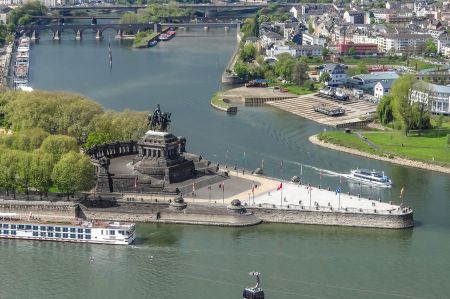Deutsches Eck in Koblenz - a symbolic place
- Written by Portal Editor
Deutsches Eck is actually an artificially raised tongue of land in Koblenz at the mouth of the Moselle and the Rhine.
This symbolic place is the landmark of Koblenz and the start and end point of numerous cycling and hiking trails along the two rivers. The Kaiser Wilhelm monument still stands on the "Deutsches Eck" headland. It was not until the 19th century that the area was connected to an offshore sandbank via a pier. The original idea was to create a port of refuge at the mouth of the Moselle. In the Koblenz vernacular, the pier and sandbank were called Honsschwanz because geographically they formed the last foothills of the Hunsrück. At the end of the 19th century, the harbour was filled in again, which made it possible to build the Kaiser Wilhelm Monument at this point in the first place.
The Kaiser Wilhelm Monument at the Deutsches Eck
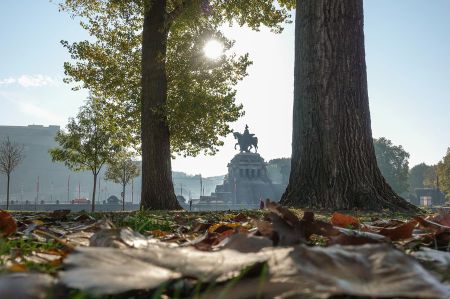 Shortly after the death of Kaiser Wilhelm I, the idea arose to erect a memorial to the Kaiser, who had brought about the complete unification of Germany after three wars. Three years later, in 1891, Kaiser Wilhelm II, the grandson of the deceased, chose the Deutsches Eck in Koblenz as a suitable location.
Shortly after the death of Kaiser Wilhelm I, the idea arose to erect a memorial to the Kaiser, who had brought about the complete unification of Germany after three wars. Three years later, in 1891, Kaiser Wilhelm II, the grandson of the deceased, chose the Deutsches Eck in Koblenz as a suitable location.
With the settlement of the Teutonic Order at the confluence of the Rhine and Moselle in 1216, this historic square received its name "Deutsches Eck". Archbishop Theoderich von Wied summoned the Knights of the Teutonic Order to Koblenz in 1216 and gave them part of the grounds of the Kastor Church, including the St. Nicholas Hospital located there.
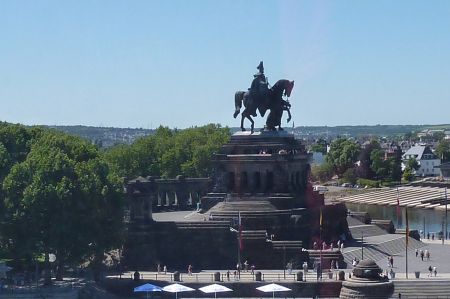 The Deutschordensballei, which was set up soon afterwards, was subordinate to the grand master of the order. Soon after the establishment of the Teutonic Order, this site, which at that time still stood directly on the headland of the confluence of the Moselle and Rhine, bore the designation Deutscher Ordt and then the name Deutsches Eck.
The Deutschordensballei, which was set up soon afterwards, was subordinate to the grand master of the order. Soon after the establishment of the Teutonic Order, this site, which at that time still stood directly on the headland of the confluence of the Moselle and Rhine, bore the designation Deutscher Ordt and then the name Deutsches Eck.
At the extreme end of this promontory, a monumental equestrian statue was erected in memory of Emperor Wilhelm I, who died in 1888, at the behest of the Prussian Rhine Province. The decision for the location of the monument was left to the young Kaiser Wilhelm II, who decided in 1891 for the confluence of the Rhine and Moselle.
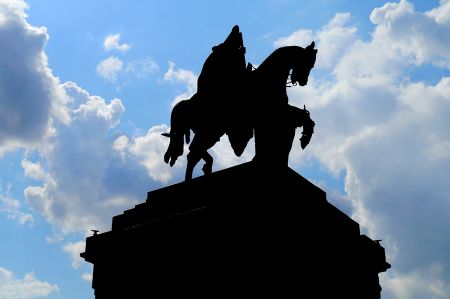 It was then that the Deutsches Eck got its current shape. After 1 million marks were available, construction began in 1893. Bruno Schmitz (Berlin) was responsible for the layout and base architecture, and the equestrian statue was created by Emil Hundrieser (Berlin). On August 31, 1897, the Kaiser Wilhelm monument was inaugurated in the presence of Kaiser Wilhelm II. From now on, the name Deutsches Eck shifted from the Deutschordensballei to the new monument.
It was then that the Deutsches Eck got its current shape. After 1 million marks were available, construction began in 1893. Bruno Schmitz (Berlin) was responsible for the layout and base architecture, and the equestrian statue was created by Emil Hundrieser (Berlin). On August 31, 1897, the Kaiser Wilhelm monument was inaugurated in the presence of Kaiser Wilhelm II. From now on, the name Deutsches Eck shifted from the Deutschordensballei to the new monument.
On August 31, 1897, the copper-worked monument to Kaiser Wilhelm I was inaugurated in the presence of Kaiser Wilhelm II.
The viewing platform has been preserved.
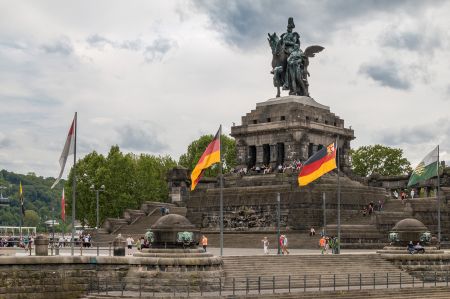 A double-barrelled, backwards through a flat-arched wall with a closed staircase leads to the monument on both sides of a base, the front of which is adorned with an eagle over fire with tongued snake heads and the inscription "William the Great". On this base plateau stands the multi-stepped base for the equestrian statue, supported by mighty narrow columns. The headland of the site is surrounded by iron bars, and the shipping pier is marked with lion heads.
A double-barrelled, backwards through a flat-arched wall with a closed staircase leads to the monument on both sides of a base, the front of which is adorned with an eagle over fire with tongued snake heads and the inscription "William the Great". On this base plateau stands the multi-stepped base for the equestrian statue, supported by mighty narrow columns. The headland of the site is surrounded by iron bars, and the shipping pier is marked with lion heads.
The memorial was an expression of the Wilhelmine zeitgeist and was already criticized at the time of its creation for its overloaded, nationalistic symbolism (e.g. by Kurt Tucholsky in his report "Denkmal am Deutschen Eck").
Destruction by American artillery shells
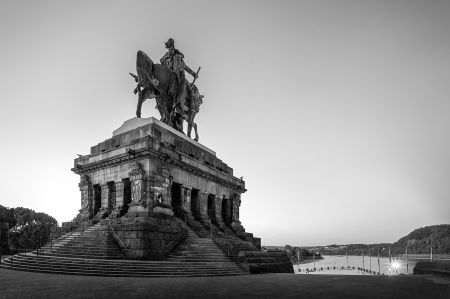 Shortly before the end of the Second World War, on March 16, 1945, the equestrian statue was destroyed by an American artillery shell. The French military government planned to demolish the monument and replace it with a new "Memorial for Peace and International Understanding". However, due to lack of funds, these plans were not implemented. On May 18, 1953, Federal President Theodor Heuss declared the remaining base a memorial to German unity. The coats of arms of all German states and the former eastern territories were used around the base. On the Day of German Unity, October 3, 1990, the names of all the former federal states of the GDR were placed on two plaques facing each other.
Shortly before the end of the Second World War, on March 16, 1945, the equestrian statue was destroyed by an American artillery shell. The French military government planned to demolish the monument and replace it with a new "Memorial for Peace and International Understanding". However, due to lack of funds, these plans were not implemented. On May 18, 1953, Federal President Theodor Heuss declared the remaining base a memorial to German unity. The coats of arms of all German states and the former eastern territories were used around the base. On the Day of German Unity, October 3, 1990, the names of all the former federal states of the GDR were placed on two plaques facing each other.
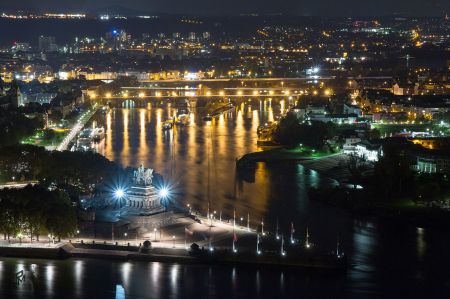 Until 1993, a flagpole with the federal flag took the place of the destroyed equestrian statue.
Until 1993, a flagpole with the federal flag took the place of the destroyed equestrian statue.
After the fall of the Berlin Wall, three original concrete elements of the Wall were placed next to the memorial.
Please read as well:
